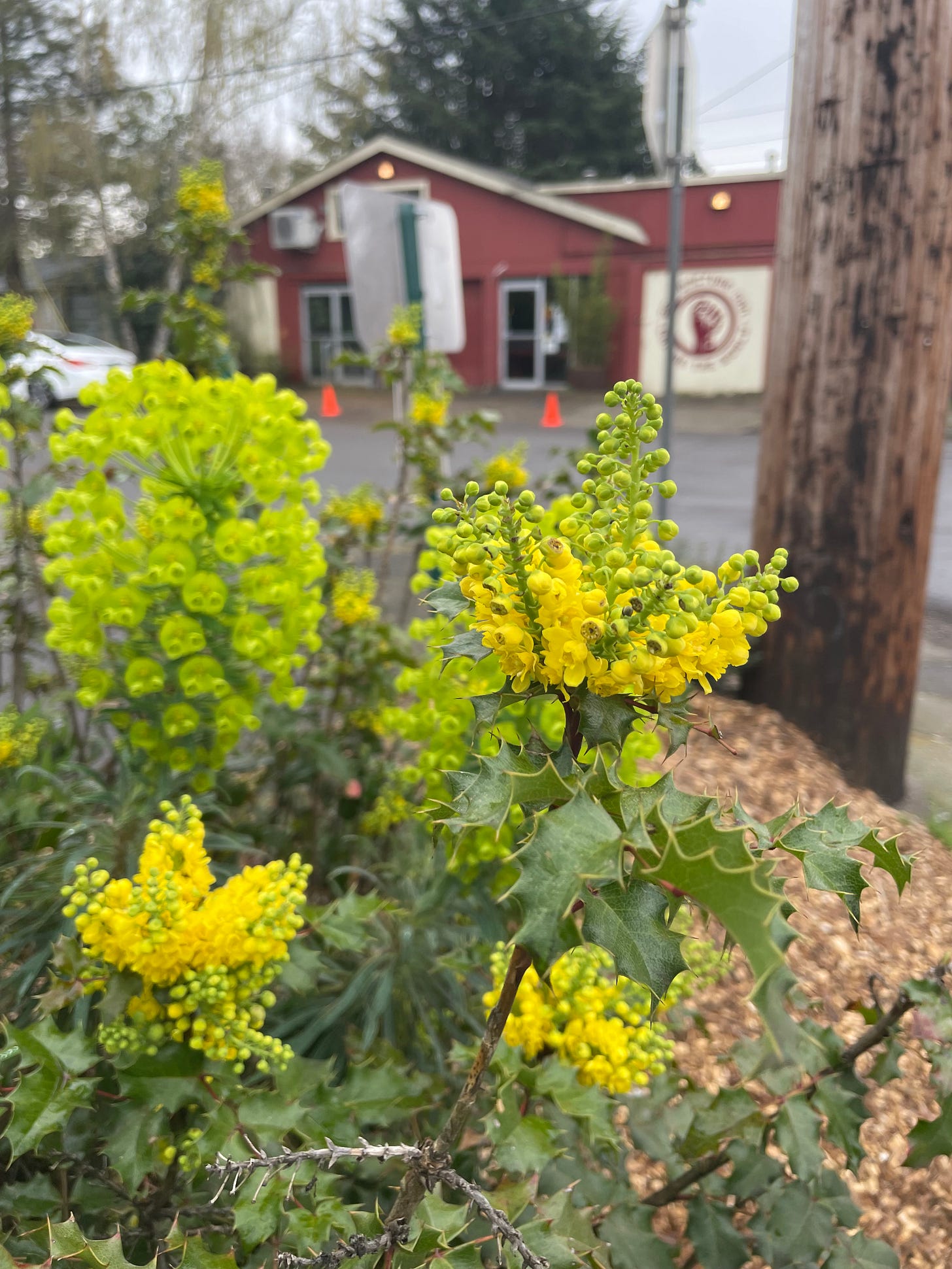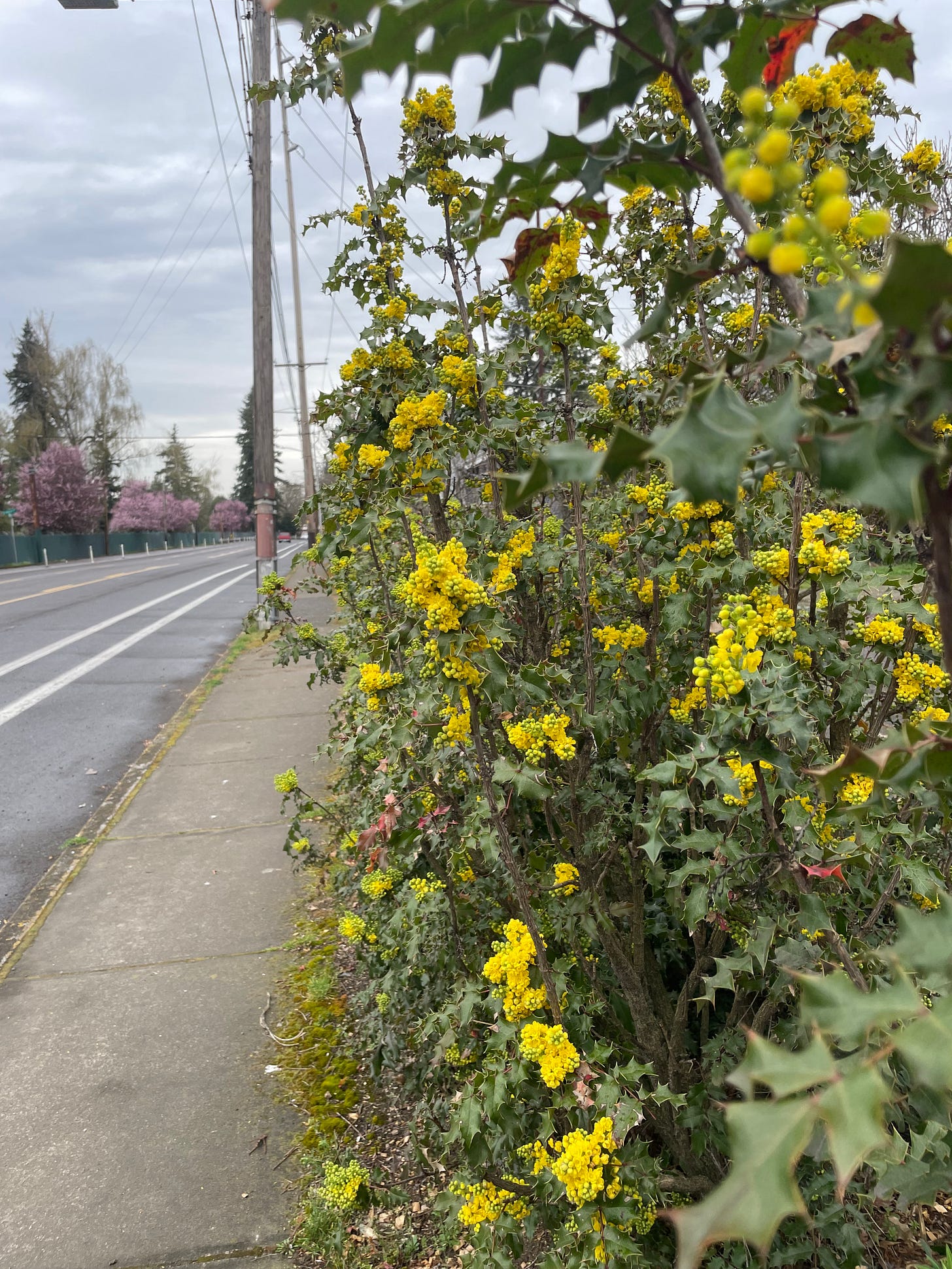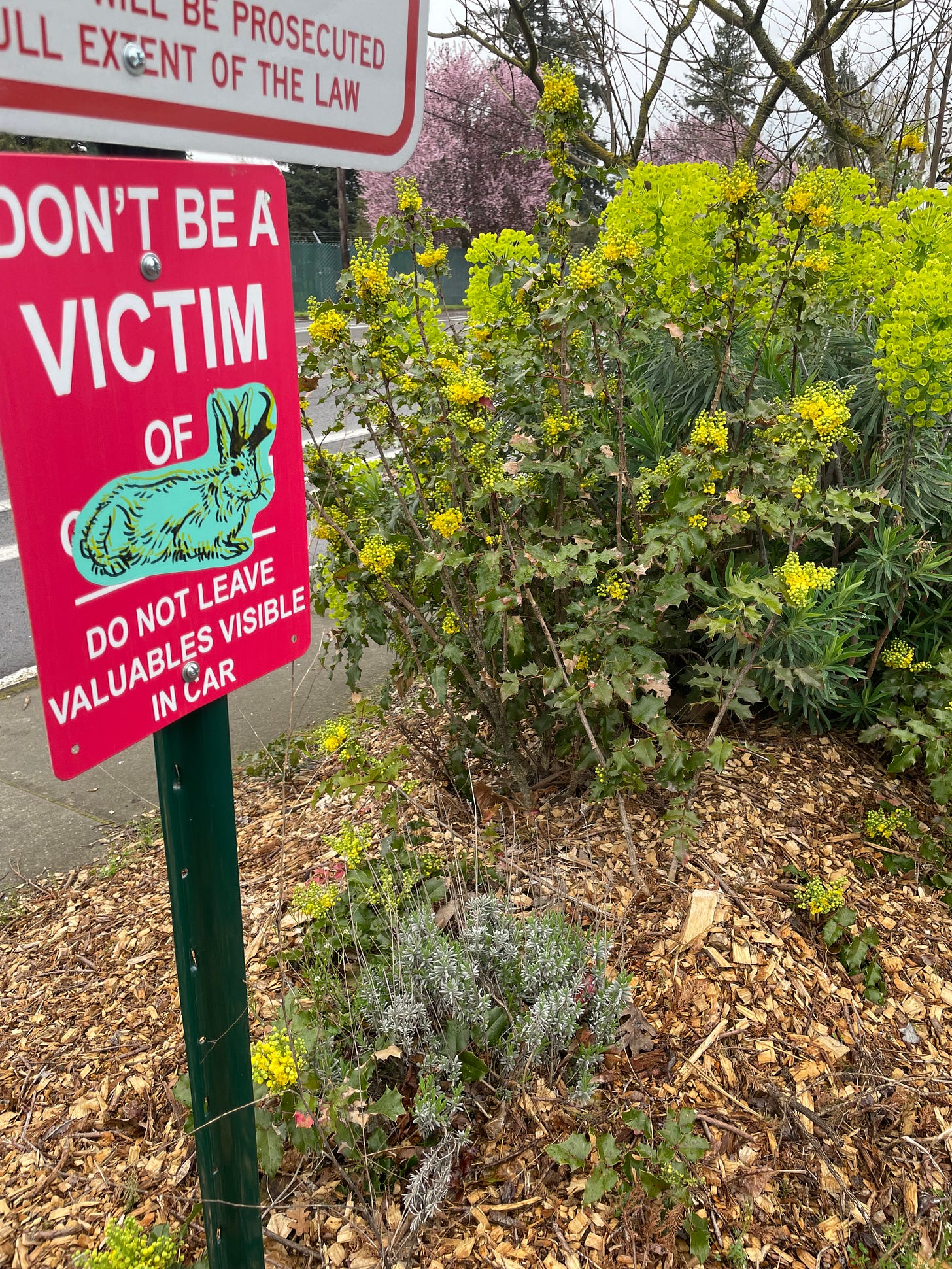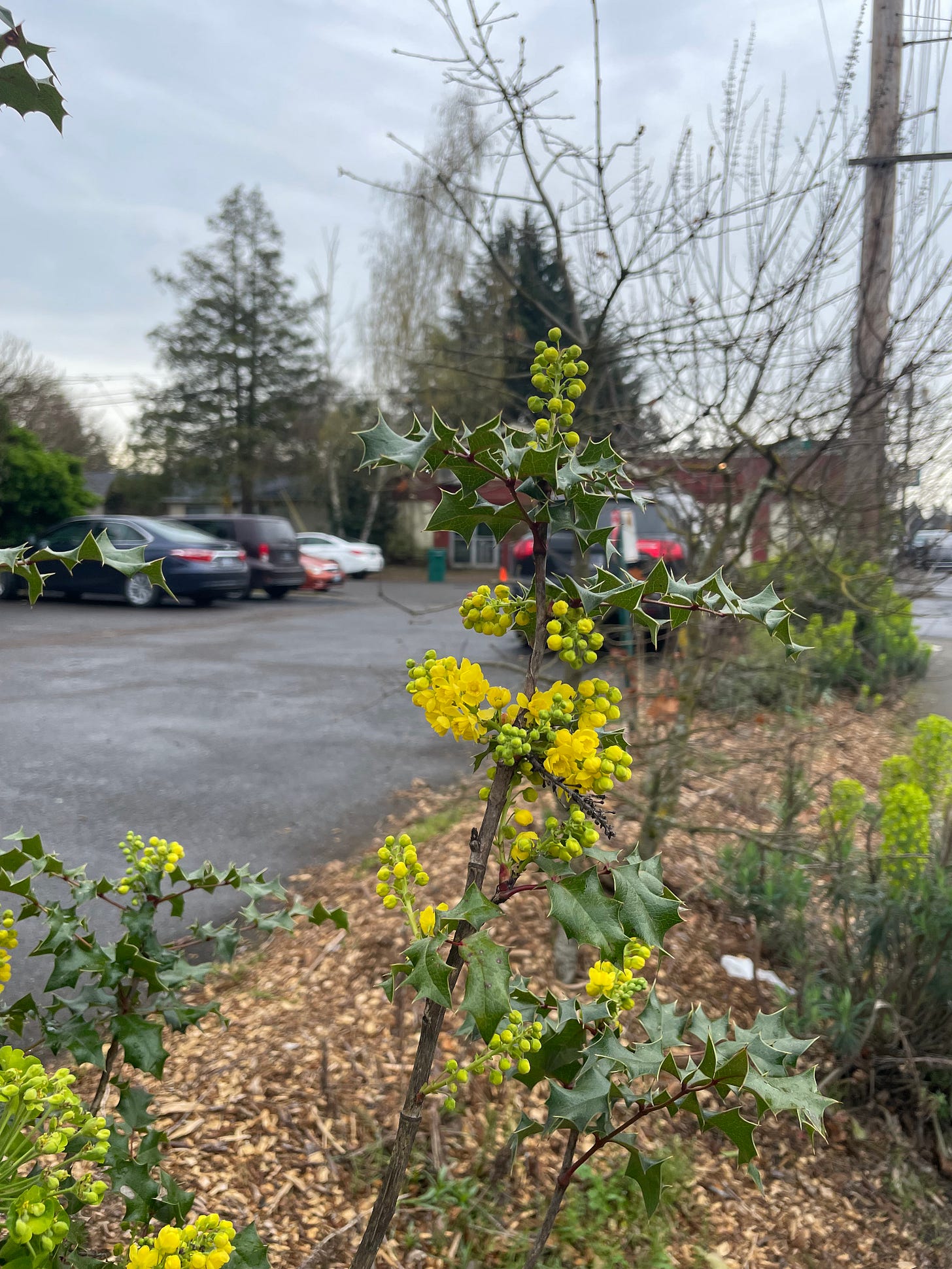For the first post of this series, see Hellstrip in Winter. Sorry, everyone, I really love WCA Cully’s hellstrip garden so I’m going to keep writing about it all year. Our decade-plus experiment with trying to create habitat for pollinators in the parking strip encompasses so many things I like (which also happen to be themes of this newsletter). Making our hellstrip was about embracing a makeshift and incremental version of gardening — creating something that worked for us by using the space and the resources that we had, whether or not it matched what a garden was supposed to look like — and figuring it out as we went along (wayfinding, the botanical kind).
This is also a post about thresholds (see Part One and Part Two). And acupuncture schools, both living and dead.
Every one of the ten Oregon grapes, which I planted as bareroot sticks in 2010, are now in bloom and they smell delicious (even if you’re not a pollinator; I bet they smell even better if you are):
Back in 2010, there was a big conversation in the acupuncture profession about entry-level degrees. The dominant narrative, especially among the schools, was that the minimum education required to become a licensed acupuncturist needed to change, from a three-year Master’s degree to a four-year doctoral degree. By that time, WCA had been hiring (or attempting to hire) acupuncturists for five years, and we already had plenty of reasons to be concerned about the cost and difficulty of becoming an acupuncturist. We were pretty sure that making the entry level requirements longer and even more expensive would be a disaster for WCA.
So we tried to fight the new doctoral degree. I’ll spare you the details. It didn’t work, and part of how I dealt with my frustration was planting tiny, spiky Oregon grapes in an unpromising location. I spent many hours of the spring of 2010 on my knees in the parking strip, getting soaked, muddy, and exhausted — and that’s how I came to terms with the necessity of making our own school. The other acupuncture schools were saying it was inevitable that they’d get rid of the Master’s degree (because longer and more expensive obviously equals better). WCA needed a program that wouldn’t do that and nobody was going to just hand one to us (yes, we did ask). By the end of 2012 we were raising money for POCA Tech, and by fall 2014 it was open. And now it’s ten years old.
So it was like a multi-year threshold process: we started out in a place where all we could do about our problems with acupuncture education was to complain to people who had no reason to care — and we ended up in a place where 60% of the acupuncturists who work for WCA are graduates of the acupuncture school that we made, the school that offers not a doctoral degree but a three-year Master’s level certificate (for half the cost of any other US acupuncture program). On one side of the threshold, we were unhappy consumers and on the other side, we’re empowered producers.
But we could only cross that threshold incrementally, and in a makeshift, improvisational way that lots of people didn’t understand or approve of. And they still don’t.
In the first Thresholds post, I wrote about being a class straddler, and in the second Thresholds post, I wrote about having complex PTSD. I learned early on with WCA that I couldn’t provide acupuncture in my neighborhood if I tried to do it the “right” way. I didn’t have enough money, I didn’t fit the role, I didn’t have the bandwidth. And most of my patients didn’t either. But if I gave myself permission to put aside what acupuncture was supposed to look like, I could access the capabilities that I developed as a straddler, an outsider, a survivor. Scarred, scrappy, stubborn — and inventive. If I allowed myself to do things in the way that I could do them as opposed to the way I should do them, I could make improbable things happen. Good things. (Though not necessarily good enough by other people’s standards.)
I knew it would be the same with making an acupuncture school. We definitely did not have the resources to do it the right way — the barriers to making an accredited acupuncture school were so high it would be a miracle if we could do it at all. But we had to start somewhere, with the tools and the skills and the people we had, if we hoped to ever get anywhere. POCA Tech was all bareroot sticks, mud, and hope.
I’m writing this for two reasons:
First, we’re about to embark on some significant changes to the WCA/POCA Tech partnership that I want to unpack in detail here, but in order to do that I had to write this post first. Ten years into our project of having a school, both WCA and POCA Tech have evolved, and they have different needs. The hellstrip gardening nature of our businesses is by far the hardest thing for people to understand about us. Even people who like us a lot often don’t get why we don’t try harder to do things “right”, or why we make things that look so weird. Sometimes I wish I could just ask everyone to go outside and stand in WCA Cully’s parking lot. And smell the flowers.
Second, one of the acupuncture schools that in 2010 was driving the effort to increase the entry-level qualifications for acupuncturists, AOMA, is shutting down. AOMA was the epitome of what an acupuncture school was supposed to be — but at the end, it gave its students only six weeks’ notice. People have asked me if I think that other acupuncture schools closing (it’s definitely a trend!) will increase the profession’s interest in POCA Tech’s model — so I wanted to give some context for my answer, which is no. The acupuncture profession isn’t interested in hellstrip gardens. It’s not an exaggeration to say that other acupuncture schools would rather die than be like us — which, you know, I try not to take too personally.
And yeah, it’s not like it’s easy to be us. Even with all the fragrant yellow flowers, the hellstrip is still a place where people toss their trash and step on the plants. But it’s alive, and that never gets boring for me. WCA and POCA Tech are alive, we’re rooted in our community and we’re still growing. To quote Ada Limón (“Instructions on Not Giving Up”), I’ll take it.






